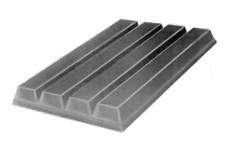18/05/2017
…is the likely response from Nestlé to the Court of Appeal following the latest ruling to reject trade mark protection of the shape of the famous four-fingered chocolate bar in the UK. The decision was handed down on 17 May 2017.
 This is an appeal from the judgment of Arnold J given on 20 January 2016. It concerns an application made by Nestlé in 2010 to register as a trade mark in the UK, the three-dimensional sign (shown above) in respect of chocolate and other goods in class 30. Click here for our last blog on this case.
This is an appeal from the judgment of Arnold J given on 20 January 2016. It concerns an application made by Nestlé in 2010 to register as a trade mark in the UK, the three-dimensional sign (shown above) in respect of chocolate and other goods in class 30. Click here for our last blog on this case.
In a statement issued by Nestlé, the company says it is disappointed with the decision and is considering its next steps. It goes on to say that this particular judgment “does not mean that our four finger-shape is now free for use in the UK or elsewhere”. The trade mark was registered in many other countries including Australia, Canada, France, Germany and South Africa, according to Nestlé.
Conversely, Mondelez (Cadbury) is “pleased” with the decision and “[does] not believe the shape of the KitKat bar should be protected as a trade mark in the UK”.
As Lord Justice Floyd nicely explains in the decision, “I have found it helpful to have in mind a basket of unwrapped and otherwise unmarked chocolate bars, in the shape of the mark applied for, available for selection in a shop or supermarket. For there to be acquired distinctiveness, the consumer must perceive these goods as being Kit Kats, or as originating from the people who make Kit Kats, and not from others. A perception that they looked like Kit Kats is not enough. Acquired distinctiveness carries with it an indication of exclusive trade origin.”
In an earlier decision issued by the Hearing Officer, he concluded that the survey evidence put forward by Nestlé did not establish acquired distinctiveness because it was not possible to tell from the survey how many respondents were sure that the shape shown to them was a KitKat.
Sir Geoffrey Vos concludes in the Court of Appeal decision that “the Hearing Officer obviously did not think that the evidence went as far as to show that the consumer would perceive the bars in the basket as originating from Nestlé and not from others”.
The problem Nestlé had is that it was not able to show that it had promoted the shape itself as a trade mark. Yes, it is a popular (and tasty) chocolate bar but it is always sold in opaque packaging with the KitKat logo taking centre stage. In all promotional materials and at the point of sale, the shape is not visible to consumers. The Courts question whether consumers use the shape of the chocolate bar itself to identify the origin of the goods; Nestlé was unable to provide convincing evidence that consumers do.
This does not suggest all is doom and gloom for shape marks, or even for Nestlé in its quest to protect this shape in future. If you have a shape for which you want to seek trade mark protection, use it; put the shape in front of the public and make it visible. This could be on, for example, promotional materials or advertising boards that people see as they walk down the street. Or maybe the shape of the product is presented for all to see in transparent packaging. If the shape is promoted as the way to recognise the producer of the product, this will be important evidence if you are faced with registration problems.
As for this ongoing chocolate war, we expect another few rounds between these two confectionery giants.
This article is for general information only. Its content is not a statement of the law on any subject and does not constitute advice. Please contact Reddie & Grose LLP for advice before taking any action in reliance on it.

